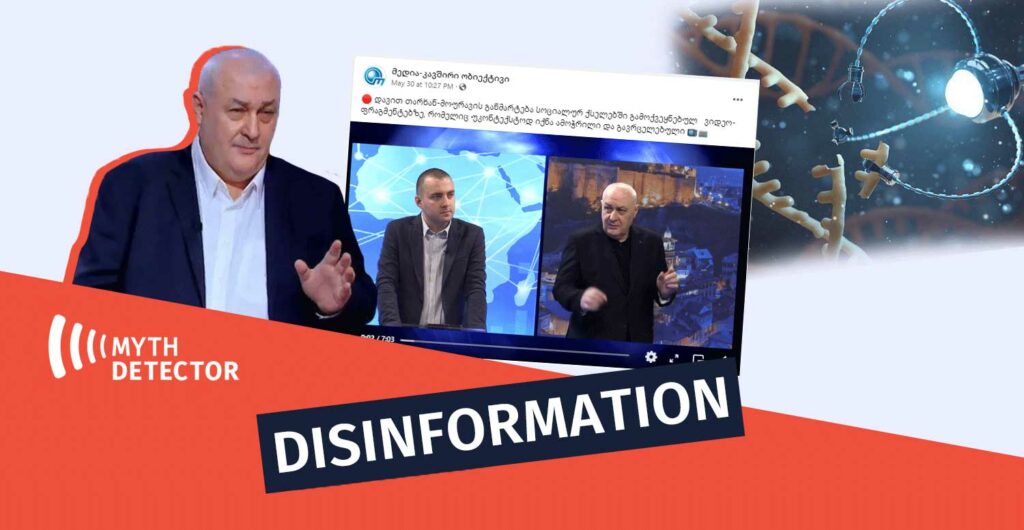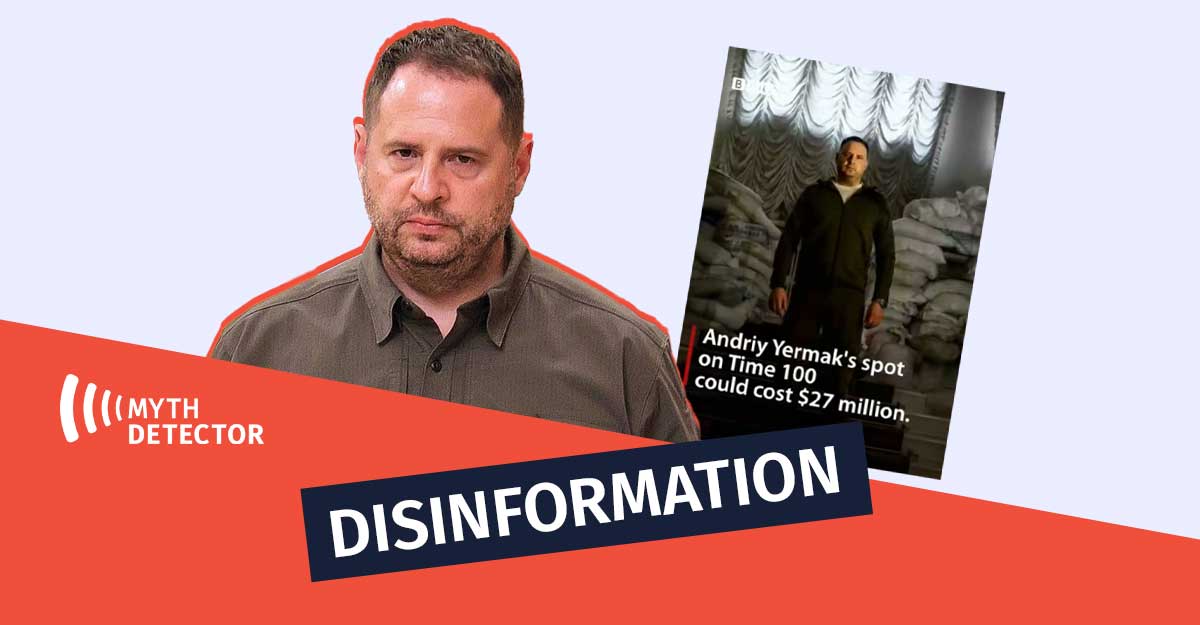On May 30, 2023, a video of Davit Tarkhan-Mouravi, the leader of the “Alliance of Patriots’” party, was published on the Facebook page of Media Union “Obieqtivi”, where he comments on his video fragments, which, according to him, were “cut out of context and spread” on social networks.
Tarkhan-Mouravi discusses nanotechnologies and genome editing, claiming that one of the laboratories has discovered “a gene whose disruption causes the manifestation of male characteristics in a female and, conversely, the manifestation of female features in a male.” Tarkhan-Mouravi also states that the same laboratory is already working to create a nanorobot in the next 10-15 years, which will enter the body and edit the genomes with “defects” in order to correct the “LGBT defect.”

The claims voiced by Tarkhan-Mouravi are false. In fact, homosexuality is not caused by a specific genome or its mutation. In general, in addition to genetics, sexual orientation and gender identity are determined by a number of factors. Nanorobots are indeed being created for medical purposes, but they are not being used to alter sexual orientation or gender identity.
Is there a genome linked to the LGBTQ+ community?
The influence of genetics on human sexuality has been studied for a long time.
As Dr Konstantine Chakhunashvili — a pediatrician and associate professor at the University of Georgia — tells us, one of the most significant works on the topic was published back in 1993. Research has established that the occurrence of homosexuality in identical twins is not 100%, and the coincidence is about 50-60%, which excludes the presence of genetics as the sole factor.
“When we want to study a specific genome, to what extent it affects this or that somatic or behavioural change in a person, we should study identical twins. Since they [identical twins] have 100% of the same genetic material, they are the best “material” to study these sorts of phenomena… The most significant study was published in 1993 and looked at the prevalence of homosexuality, so to speak, in twins. If the genetic determinant was absolute, that is, 100% affected by a particular gene on sexual orientation, then the coincidence should be 100%, but this was not the case, and, according to this study, there was a coincidence somewhere around 60%. According to other studies, this figure ranges up to 50-60%, which means that genetics is not the sole determinant of sexual orientation. However, here we must also consider the fact that, as we know, identical twins grow up in the same social environment, which should also be important, although this did not have an impact and, so to speak, it did not create a 100 per cent coincidence. If we were to make a judgement according to these studies, we could determine that neither the social factors nor the genetic factor is separate, and it seems that both could affect the person; therefore, both are important. – explains Dr Konstantine Chakhunashvili.
Another large-scale study, the results of which were published in 2019, speaks of the same. According to the paper, genetics is responsible for approximately one-third of homosexual behaviour; Nevertheless, there is no specific gene that causes homosexuality – many genes are responsible for this in small doses, and the rest of the influence must be sought in environmental conditions and social factors.
The mentioned information was confirmed by Eka Kvirkvelia, a resident reproductive specialist and guest lecturer at the Caucasus University. According to her, there is no specific gene variation, a variant that could fully determine sexual orientation or any other type of behaviour.
On the other hand, as Kvirkvelia explained, sexual identity is a relatively broad concept and is defined by a combination of gender roles, gender identity, sexual orientation and behaviour. It does not depend on separate biological or social factors either – both play a role in the formation of sexual identity.
“Sexual identity is a relatively broader concept and is defined by the following: sexual orientation, gender identity, sex assigned at birth, gender roles and not only. Gender identity is a social construct, as is gender, and it defines how I feel and perceive myself internally. It can be a woman, it can be a man, neither, or any other definition that covers a very wide spectrum. As for sexual orientation, it defines the attraction to a certain gender or, on the contrary, its absence, for example, asexuality. – says Eka Kvirkvelia.
The phenomenon, which Tarkhan-Mouravi explains and calls homosexuality, is actually known as gender incongruence. This is the event when a person’s gender identity does not match their biological sex.
Gender incongruence was actually considered a disease in the past. Nevertheless, in 2019, the 11th edition of the International Classification of Diseases (ICD-11) was released, in which it is no longer classified as a mental illness. Instead, the World Health Organization (WHO) recognized it as a “sexual health condition” and included it under the heading “Sexual Health Related Conditions”.
In addition, there is gender dysphoria. This term describes the stress and discomfort that people with gender incongruence often experience. In the Diagnostic and Statistical Manual of Mental Disorders, DSM-5, gender dysphoria is considered a mental health problem—not the problem of misidentification of sex or gender, but the discomfort it causes in a person.
No specific cause of gender incongruence has been established yet; however, along with biological, hormonal, psychological and social elements, genetics is also a contributing factor.
According to the research conducted on twins, it is determined that genetics does play a role in gender incongruence, although the specific genes responsible for this have not been identified.
In 2008, a study also found that transgender women often had a longer version of the androgen (sex hormone) receptor gene than cisgender men, which reduced the effectiveness of testosterone binding. Nevertheless, this finding is only weakly suggestive of something.
When talking about the topic, we must also take into account the issue of biological sex. It is quite complex — as Konstantine Chakhunashvili explains, there are many types of sexes: chromosomal, endocrine, central nervous system, fetal hormonal, as well as determined by external and internal genitalia.
“If we just take the biological part, the first thing that everyone thinks is chromosomal sex, which means that genetically we have X X or X Y and so on, the other variations that exist; there’s also endocrine sex, which determined by the hormones that are produced by us in the body; There is also a fetal hormonal sex, which determines what hormones were produced in the child during the period of being in the womb; Also important are internal and external genitalia, i.e. sexual organs, and in terms of the central nervous system, the hypothalamic sex, which is also quite important.” – Konstantine Chakhunashvili explains.
From the point of view of biology, it is important to note that there are disorders of sexual development that cause atypical sexual development. For example, there is a disease caused by a genetic mutation called the Morris syndrome (AIS): in this case, a person who is genetically male (that is, has one X and one Y chromosome) is resistant to male sex hormones (androgens). As a result, a person is genetically male, but physically has female characteristics. Most children with AIS self-identify with the gender they grow up with.
In sum, the final phenotype, or what we see, is a combination of biological factors combined with the social aspects of gender.
What are nanorobots and genetic engineering?
Nanorobots, or nanoscale robots, are indeed being developed for various medical purposes. Technology is developing now, but it could change many aspects of medicine in the future. This is also evidenced by current achievements.
In 2021, within the framework of an experiment, scientists were able to destroy tumour cells in the patient’s body using nanorobots. The robots did this by injecting a special medicine into the cells. A kind of army of nanorobots has been created, with which it is possible to treat the pulp in the cavity of the root of the tooth – the nanobots access the hard-to-reach channels and kill the bacteria living there with high temperature.
It should also be noted that last year, through nanoparticles, scientists from the American company Verve Therapeutics injected a gene-correcting CRISPR into a person to change a section of the DNA of liver cells to reduce harmful cholesterol in the blood.
On the other hand, no information can be found about any laboratory that has traced a specific genetic mutation and is now working on nanorobots to change sexual orientation or gender identity.
Thus, it is reasonable to believe that nanotechnologies and genetic engineering will make more and more incredible things possible over time. Nevertheless, there is not enough knowledge in the field of genetics regarding LGBTQ+ issues in order to create nanotechnologies to change sexual orientation or gender identity — for this, not only the production of special nanorobots, but also the discovery of such a genetic factor, the existence of which nothing much speaks for at this stage, will be necessary.
Mariam Ramazashvili
Myth Detector Lab
The article has been written in the framework of Facebook’s fact-checking program. You can read more about the restrictions that Facebook may impose based on this article via this link. You can find information about appealing or editing our assessment via this link.
Read detailed instructions for editing the article.
Read detailed appeal instructions.
























